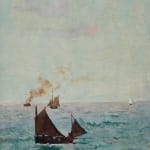Alfred Stevens (1823-1906)
Further images
Born in Brussels on May 11, 1823, Alfred Émile Léopold Stevens spent most of his life in Paris, earning the epithet “the Fleming who was more Parisian than most Parisians.” Immersed in Parisian society, Stevens forged friendships with Delacroix and Degas. He shared a studio with Manet and served as a pallbearer at his funeral in 1883, alongside Monet and Émile Zola. As one of the most celebrated artists of the Belle Époque, Stevens was recognized with medals at the Expositions Universelles, the Grand Prix in Paris, and with the distinguished titles of Commander of the Légion d’Honneur and Grand Officer of the Ordre de Léopold II.
Stevens captured the lives of upper-class Parisian women, who seemed to have nothing better to do than wait. In their lavish nineteenth century salons decorated with silk fabrics and lacquered furniture, perceived as fundamentally shallow, Stevens portrayed their superficial beauty with an undercurrent of melancholy and boredom. Stevens’ mastery of these tangible textures and decadent decors successfully distracts the viewer from the mysteries beneath the fleeting facade.
Despite financial difficulties in his later years, Stevens remained a prolific artist and influential teacher, mentoring Sarah Bernhardt and William Merritt Chase. His impact extended to Vincent van Gogh, who mentioned Stevens in four letters to his brother Theo.[1] Among his many achievements was his contribution to the monumental Panorama du Siècle and a retrospective exhibition at the École des Beaux-Arts in 1900, cementing his legacy as a pivotal painter of the nineteenth century.
The 1880s started rather badly for Stevens.[2] A heavy smoker, he was diagnosed with chronic bronchitis in 1880, exacerbated by years of inhaling turpentine fumes. Advised to seek the therapeutic sea air, Stevens entered an arrangement with his gallerist Georges Petit, who offered him an annual stipend of 50,000 francs for three years, financing seaside retreats in exchange for exclusive rights to his artistic output. Over nearly fifteen years, Stevens spent summers in coastal towns from Normandy to the Mediterranean, producing hundreds of seascapes, a much-praised part of his oeuvre.
At first, the paintings featured the fashionable Parisian bourgeoisie enjoying coastal retreats, blending elegance and leisure with seaside idyll. Eventually, Stevens shifted his focus to the ocean itself, capturing its mysterious moods. These late works, influenced by the nocturnes of his friend James McNeill Whistler, reference Dutch compositions morphed in a symbolist style. The moonlit waters and atmospheric textures of these paintings evoke a sense of nostalgia and introspection, reflecting the oscillation in Stevens’ own life between depressed solitude and cheerful society.
One of the most influential, yet underappreciated Belgian artists of the nineteenth century, Stevens captured the interplay of tranquility and turmoil in his interiors and outside. His melancholic marines, with their sparkling light and dynamic reflections, transport viewers to the liminal space between reality and imagination, inviting them to ponder the untold stories hidden under the shiny surface.
[1] Vincent van Gogh. The Letters, 004 To Theo van Gogh. The Hague, Tuesday, 28 January 1873; 500 To Theo van Gogh. Nuenen, Monday, 4 and Tuesday, 5 May 1885; 515 To Theo van Gogh. Nuenen, on or about Tuesday, 14 July 1885; 550 To Theo van Gogh. Antwerp, Monday, 28 December 1885.
[2] Danielle Derrey-Capon, in: Alfred Stevens 1823-1906, Brussels & Amsterdam 2009, pp. 39-41
Provenance
Private collection, FranceHotel des Ventes, Avignon, 20 April 2024, lot 144





